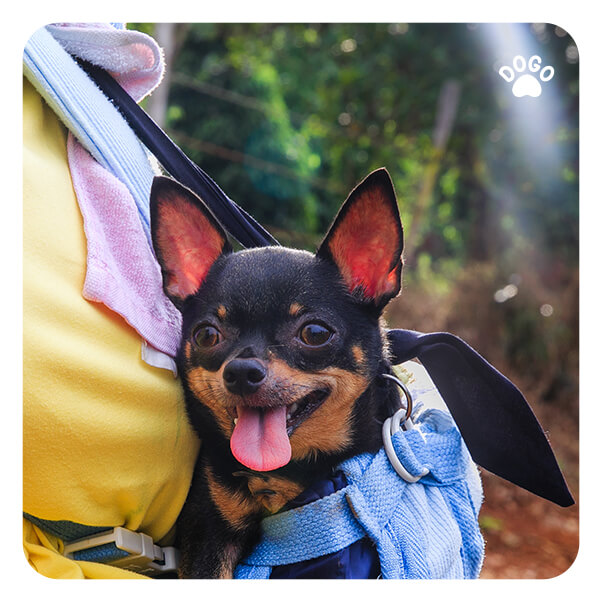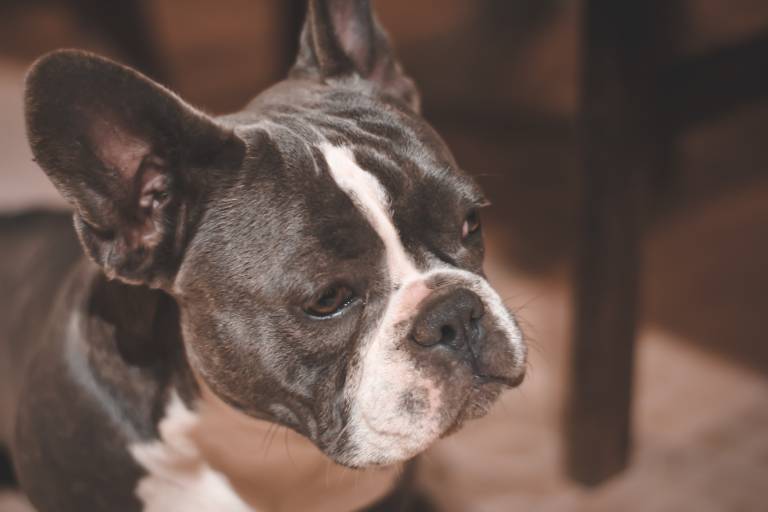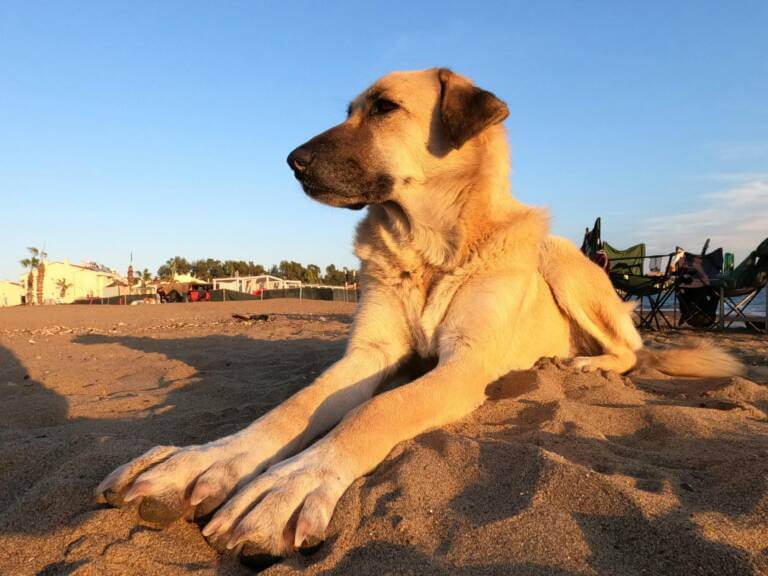Dog Panting Explained
Post Date:
November 7, 2023
(Date Last Modified: November 13, 2025)
Panting in dogs is a breathing behavior that involves open-mouth respiration and changes in airflow and moisture to influence body heat and breathing effort.
What is panting?
Panting is rapid, open-mouth breathing during which air flows over the moist surfaces of the tongue and upper respiratory tract to promote evaporative cooling and increase ventilation; this mechanism contrasts with human thermoregulation that relies heavily on sweat glands in the skin.[1]
At rest, a typical adult dog’s respiratory rate ranges from about 10 to 35 breaths per minute, and panting can raise minute ventilation manyfold to increase heat exchange and carbon dioxide removal.[2]
Normal contexts for panting
Panting is commonly seen after activity and in warm environments; owners should expect a dog to pant after exercise and to gradually return to a baseline breathing pattern over minutes to an hour depending on intensity and temperature.[3]
- Exercise and recovery: panting after moderate exercise typically subsides within 10 to 30 minutes in healthy dogs under cool conditions.[4]
- Excitement or mild stress: short bursts of panting may occur with greeting, anticipation, or brief anxiety and usually resolve as the dog calms.[4]
- Age and breed differences: puppies and senior dogs may pant more frequently, and brachycephalic breeds often pant at baseline because of upper airway conformation.[2]
Patterns of panting and what they suggest
Intermittent panting that stops with rest or removal of a stimulus is frequently benign, while continuous panting that persists for hours or increases in depth and effort may indicate pathology; persistent panting beyond 2 hours without improvement should prompt veterinary evaluation.[5]
Shallow, rapid panting often reflects heat dissipation or mild anxiety, whereas deep, noisy or labored panting that includes open-mouth drooling, wheeze, or stridor suggests respiratory compromise or pain and requires prompt assessment.[2]
| Pattern | Likely causes | Owner action |
|---|---|---|
| Short bursts after play | Normal heat dissipation | Rest, shade, water |
| Continuous for >2 hours | Pain, endocrine disease, cardiac or respiratory disease | Contact veterinarian |
| Labored or noisy panting | Airway obstruction, pulmonary disease | Seek immediate care |
| Rapid panting with collapse | Heatstroke, shock, severe cardiac compromise | Emergency transport |
Heat-related panting and heatstroke
Ambient temperature, humidity, dense or dark coats, and obesity all reduce a dog’s ability to cool, and humidity in particular impairs evaporative cooling from the respiratory tract; high humidity markedly increases risk of overheating at temperatures commonly described as dangerous in warm climates.[3]
Heat exhaustion may include heavy panting, excessive drooling, and weakness, while heatstroke is usually accompanied by persistent panting with collapse, neurological signs, or a rectal temperature at or above 104°F (40°C); a core temperature of 106°F (41.1°C) or higher greatly increases the risk of permanent organ damage.[1]
Confined vehicles are a major risk factor because interior temperatures can rise rapidly, and dogs left in parked cars can reach critically high body temperatures within minutes under common summer conditions; avoid leaving a dog in a closed vehicle even for brief periods.[3]
Behavioral and emotional causes
Fear, separation anxiety, travel stress, and noise phobias commonly produce panting that correlates with the stressful stimulus and often co-occurs with pacing, trembling, or vocalization; distinguishing situational panting from medical causes depends on whether the panting reliably coincides with identifiable triggers.[5]
Pain-related panting is often persistent and may be accompanied by guarding behaviors, reluctance to move, or changes in appetite and elimination; when panting follows an injury or occurs with other signs of distress, medical evaluation is indicated.[4]
Medical conditions that cause pathological panting
Lower airway or parenchymal lung disease such as pneumonia, pulmonary edema, or bronchitis can produce increased respiratory effort and audible abnormal lung sounds on auscultation; these conditions often present with tachypnea and hypoxia detectable by pulse oximetry or blood gas testing.[4]
Cardiac disease may lead to panting via congestive heart failure and pulmonary edema; affected dogs frequently show exercise intolerance and may have elevated respiratory rates at rest that worsen over days to weeks.[1]
Endocrine and metabolic causes include hyperadrenocorticism (Cushing’s) and anemia; fever and certain toxins can also drive persistent panting and should be ruled out with bloodwork when panting is unexplained or accompanied by other systemic signs.[4]
When to seek immediate veterinary care
Seek emergency care if a dog has severe difficulty breathing, fainting or collapse, seizures, severe disorientation, or blue or very pale mucous membranes, as these signs indicate life‑threatening respiratory or circulatory compromise.[3]
If panting persists for more than 2 hours without improvement, if active cooling fails to reduce heavy panting, or if rectal temperature measures at or above 104°F (40°C), prompt veterinary assessment is warranted.[1]
Rapid deterioration after exercise or confinement in a hot environment, or the development of labored noisy breathing, are additional red flags that require immediate transport to a veterinary facility.[2]
Home first aid and safe cooling techniques
Move the dog to shade or an air-conditioned environment and loosen collars or harnesses to reduce restrictive airflow; offer small amounts of cool (not ice-cold) water and allow the dog to drink voluntarily to avoid aspiration in a weak animal.[3]
Apply tepid water to the axillae, groin, and between the hind legs and use fans to increase convective heat loss; avoid rapid immersion in ice water unless instructed by a veterinarian because overly rapid cooling can cause shock or vasoconstriction that may complicate care.[1]
Monitor respiratory rate and effort and check gum color frequently; if there is no improvement within 10 to 20 minutes or if neurological signs appear, arrange immediate transport to an emergency provider.[2]
Diagnosis and management options
A veterinarian will perform a thorough physical exam and may use pulse oximetry, thoracic radiographs, echocardiography, CBC and serum chemistry, and endocrine testing to identify causes of pathological panting; selection of tests is guided by history and examination findings.[4]
Acute management can include supplemental oxygen, intravenous fluids, analgesia, antibiotics for infectious causes, diuretics or other cardiac medications for heart failure, and corticosteroids or endocrine-specific therapy when indicated by diagnostics.[4]
When IV fluids are used for maintenance in hospitalized dogs, typical guidelines often reference orders on the order of 60 to 70 mL/kg/day as a starting maintenance rate, with adjustments for deficits and ongoing losses specified by a clinician in mL/kg/day terms.[4]
Surgical interventions for structural airway disease, weight loss plans for obese dogs, environmental modifications to reduce heat exposure, and behavioral modification or medication for anxiety-related panting are part of long‑term management tailored to the underlying diagnosis.[5]
Follow-up care and monitoring
After an acute panting episode that prompted treatment or cooling, many clinicians recommend a recheck exam within 48 to 72 hours to confirm clinical improvement and reassess diagnostics as needed.[4]
Home monitoring should include counting resting respiratory rate for 60 seconds while the dog is calm; sustained rates above 40 breaths per minute at rest are worrisome and warrant prompt veterinary reassessment.[2]
Pulse oximetry readings below approximately 92% on room air commonly trigger supplemental oxygen and further investigation for pulmonary or cardiac causes.[1]
If hospitalization is required for oxygen and IV support, typical observation periods range from 24 to 72 hours depending on the underlying problem and response to therapy.[4]
Prevention and routine management
Avoiding peak heat exposure during hot months is a practical preventive step; many veterinarians advise walking dogs in the cooler hours before 10:00 am or after 4:00 pm to reduce overheating risk during daily exercise.[3]
Weight management lowers the metabolic heat load and decreases the work of breathing in overweight dogs; even a 5 to 10 percent reduction in body weight can meaningfully reduce exercise intolerance and panting in obese patients when achieved under a structured plan.[5]
For brachycephalic breeds, staged surgical correction of obstructive airway anatomy and avoidance of strenuous activity in warm weather can reduce baseline panting and the frequency of acute episodes, with many dogs showing measurable improvement in respiratory effort after surgery.[2]
Chronic or unexplained panting
If panting persists despite environmental changes for longer than 2 weeks, or if it progressively worsens over days, a structured diagnostic workup including blood tests, thoracic imaging, and possibly endocrine testing is generally recommended to identify causes such as endocrine disease, chronic pain, or occult cardiac or pulmonary pathology.[4]
Behavioral causes that are frequent and predictable with specific triggers may respond to a combination of behavior modification and, when indicated, pharmacologic support under veterinary behaviorist guidance; formal behavior plans are usually trialed over 4 to 8 weeks to assess effectiveness.[5]
Communication with your veterinarian
When reporting panting, provide the clinician with a clear timeline and context: onset, duration in minutes or hours, presence of triggers, changes in activity, and any other clinical signs such as coughing, vomiting, collapse, or changes in appetite or elimination; objective measures like a resting respiratory rate and a rectal temperature (if safely obtained) are especially helpful and often requested by veterinarians.[4]
Photographs or short video clips showing the dog’s breathing pattern and any noisy respiration can assist triage teams in determining urgency; many clinics request videos lasting 15 to 30 seconds to document panting or abnormal breathing in real time.[2]
Prognosis and expectations
Prognosis depends entirely on the underlying cause: dogs with isolated heat exhaustion typically improve rapidly with appropriate cooling and supportive care, while those with advanced cardiac or severe pulmonary disease may require long‑term medical management and have a guarded prognosis; clinicians use serial assessments and diagnostics to stratify risk and guide owner expectations.[1]
Many acute infectious or inflammatory causes of panting respond to targeted therapy over 7 to 14 days, whereas endocrine disorders and chronic cardiac conditions often require lifelong monitoring and medication adjustments at intervals such as every 3 to 6 months.[4]
Key takeaways for owners
Count resting breaths per minute so you have a baseline, limit exercise during the hottest parts of the day, and seek immediate care for blue or pale gums, collapse, seizure, or severe difficulty breathing; these practical steps reduce delay to care and improve outcomes in emergencies.[3]
When in doubt, contact your veterinarian: brief phone triage can often determine whether home measures are reasonable or whether prompt in‑clinic assessment is necessary to prevent deterioration.






